Two cities, two tours and a bridge to Scandi noir
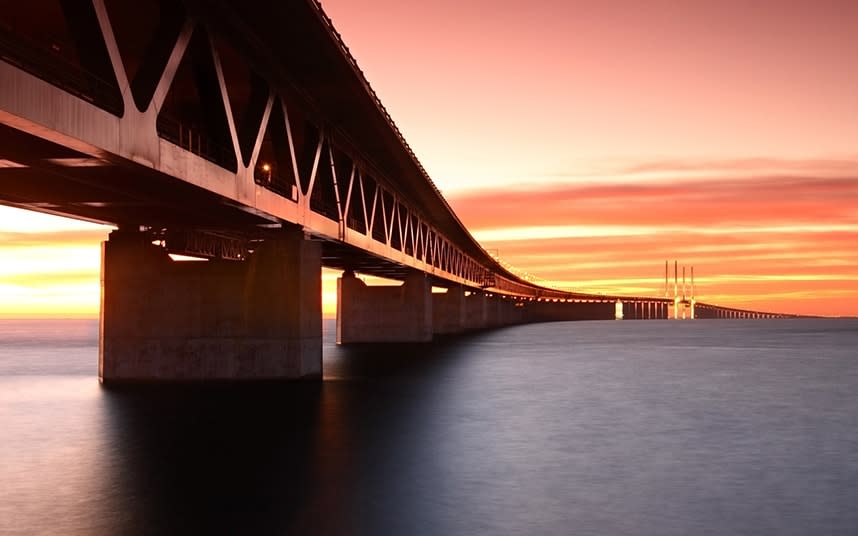
I caught my first glimpse of the bridge while coming in to land at Copenhagen airport. We were still quite high but there was no mistaking it stretching out across the expanse of rippling blue water separating Denmark from Sweden. I had dreamed of this moment; I’d had nightmares about it.
For the bridge in question – a feat of engineering that is almost 7.5 miles (12km) long and incorporates a stretch that dips into a tunnel – is the one that features so prominently in the brilliant Scandi noir crime series The Bridge.
I allowed myself a gasp. OMG. There it was in all its glory, glittering in the bright light of a sunny day, the bridge that had made an indelible impression on my consciousness during the course of numerous dark winter evenings back home spent watching episode after episode of utterly thrilling (albeit chilling) television.
I wanted to see that bridge, featured in the very first episode of series one as the place where a body, cut in two, was placed right on the line marking the international border between Sweden and Denmark. I wanted to cross it by train and by road; to see it from above and below. I wanted to breathe in the sea air surrounding it.
And I wanted to touch the strange dichotomised world of The Bridge by taking tours of both Malmo and Copenhagen in which, instead of the conventional tourist sites, the focal points would be places depicted in the drama. After all, I told myself, as an aficionado, if I was coming all this way, it would be a crime not to…

I’d hoped my tour of Malmo might be in the olive green Porsche 911 that is the distinctive trademark of Saga Noren (played by Sofia Helin) – the bewitchingly dysfunctional detective who, with her Danish counterparts, is charged with solving a string of intertwined murder plots that span both sides of the international divide, and reach into the very darkest recesses of the human psyche.
As it was, my introduction to Sweden’s third largest city was on two wheels, taking the form of a two-hour cycling tour led by a cheery Anna Toorn, who displayed real passion for her adopted home (she was originally from the far north), and celebrated the fact it had shot to stardom on the back of some pretty dark drama.
“I confess that in the past no guide would have stopped at this building,” she said, as we brought our bikes to a halt down a street containing an unattractive post-war block that served as Malmo’s police station in the drama. The building – a palliative care centre in real life – had the gritty look that characterised much of what was seen in The Bridge, most of which was shot on the Malmo side.
“When they were filming, this street would be closed off and Saga would park her Porsche right here,” said Anna. “Those days were such fun!”
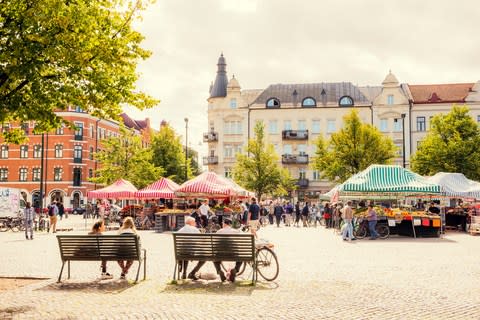
As a former centre of the herring and shipbuilding industries fallen on hard times, Malmo has more than its fair share of grit and it was this side which was depicted to such telling effect in the series. “Malmo can look bleak. In January, it is dark and grey – perfect!” exclaimed Anna.
The city has its prettier sides too. During the course of our tour, we passed through the cobbled streets of the medieval centre, complete with grand buildings dating back to the mid-17th century that testified to times of Swedish and, indeed, Danish power (for a long time this part of Sweden was under the control of Copenhagen).
Industrial decline has sparked a new creativity, Anna explained, as we passed a chocolate factory that is now a thriving cultural centre. A new university speaks of Malmo’s reinvention as a “city of learning”, and the souk-like buzz of the Mollevangstorget market was colourful testimony to the fact that, following a surge in arrivals from the Middle East and Africa, this is now a very multicultural city.
“There are challenges,” conceded Anna. “But personally I love the fact this is a place in which more than 150 languages are spoken. So vibrant. And as for the falafel… it’s incredible.”
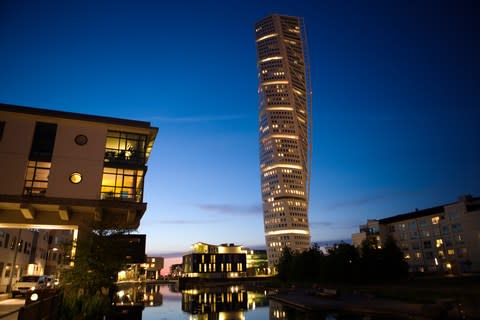
We didn’t see it on the tour, but in series two it was from the Jalla Jalla falafel store that Saga’s boyfriend called to end their relationship, and received the memorable reply: “OK, but can we continue having sex?”
What we did see, though, was the modern West Harbour district where Saga had her flat, and in which the defining structure is the “Turning Torso” building designed by Spanish architect Santiago Calatrava. Cycling here, we passed a stretch of beach – the “Malmo Copacabana” – on which people lingered in the sun, and the Ribersborgs Kallbadhus (cold bath house) in which in real life Sofia Helin is said to enjoy bracing swims.
And it was from the West Harbour that, at last, we got a spectacular view of the bridge. Ah yes, the bridge. I asked about crossing it and was told that by car there was a €50 (£44) toll; by taxi I’d need to shell out almost double that; and that there were buses. The quickest way was by train but, with the track running directly beneath the road, as I had already discovered, you don’t see a great deal if you cross the Oresund Strait that way.
I took the bus early the next day. Despite the distraction of fellow passengers clicking away all around me, it was still a pinch-me moment. I wasn’t just looking at the bridge, I was on it – right there, following in Saga’s tyre tracks. Isn’t it for experiences like these that we travel?
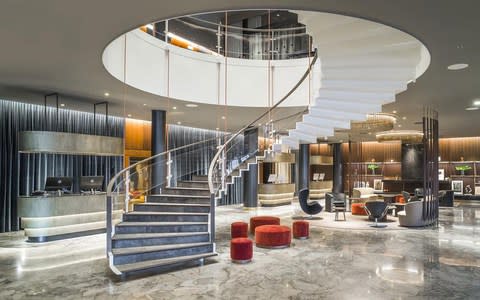
The bus journey led me to Copenhagen’s main station and a rendezvous nearby with Christine, my guide for a walking tour that was to lead to the plush Radisson hotel that featured in series two, the former meatpacking district (a useful spot to conceal a body severed in two) and the Twenties building recognisable as the brutalist police station from which the Danish detectives set forth.
Christine was an expert on all matters concerning Nordic noir and, as we walked, she talked me through the legends of the genre – Kurt Wallander, Sarah Lund (from the earlier Scandi noir hit, The Killing), and, of course, Saga herself.
“Nordic noir is full of dysfunctional anti-heroes,” she said. “But Danes don’t really see Saga as someone on the spectrum. They see her simply as a Swede: no social skills, straight to the point, a leather-wearing, Porsche-driving Swede. The Danes are more laid back, easy-going, shabby even.”
At the height of the mania for The Bridge and The Killing, Christine was leading several tours a week, and said that many of the British visitors were geekily familiar with every aspect of the cult series.
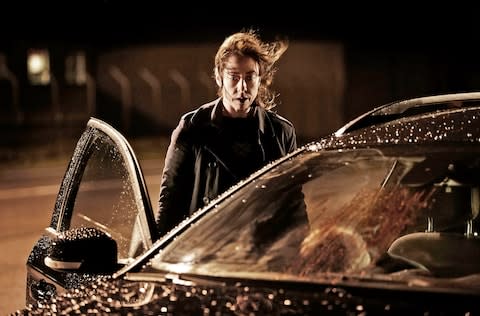
With the conclusion this year of the final series of The Bridge, interest was waning, but there were still plenty of people – like me – who wanted to get a grip on the cities that have been the backdrop to some of the best crime thriller TV of all time.
And what now? Although The Bridge appears to have run its course – in the final episode Saga throws her police badge into the Oresund Strait and in the autumn that much-coveted Porsche was sold at auction at Goodwood – it is inconceivable there will not be more in one form or another.
“I don’t know how we will carry on without Saga,” Anna had mused in Malmo. “No, I’m sure they will do another one.”
Mystery to the end. It’s murder.
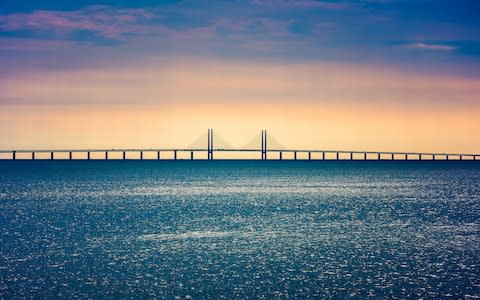
Essentials
Scandinavian Airlines (0871 226 7760; flysas.co.uk) flies from London Heathrow to Copenhagen from £55 one way.
In the heart of old Malmo, the Elite Hotel Adlon (elite.se) offers double rooms from Skr 765 (£65) a night.
In-Sight (in-sight.se/Broen/The_Bridge_Tour.html) offers coach tours of Malmo in Swedish/English, taking in sights associated with The Bridge. Cycle tours are also an option. Email info@in.sight.se.
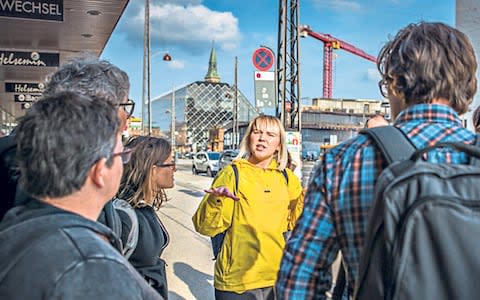
Nordic Noir Tours (nordicnoirtours.com) offers walking tours in Copenhagen from Dkr 250pp (£29) (with groups of six or more); Dkr 400pp for two.
The Bridge: The Complete Series I-IV is available on DVD from hmv.com (£29.99).
More information: visitsweden.com/malmo/ ; visitdenmark.co.uk/en-gb/copenhagen-denmark ; malmotown.com; visitskane.com


